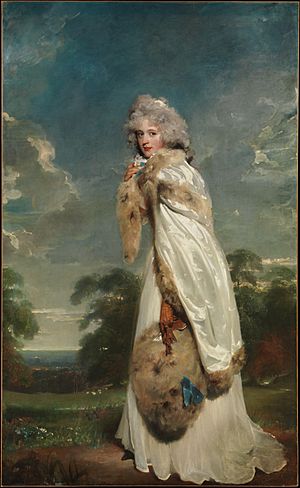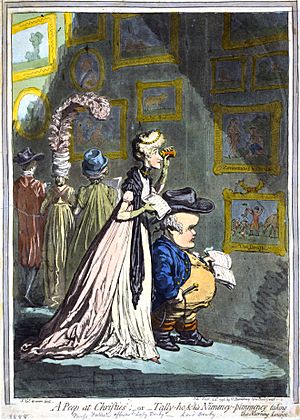Elizabeth Farren facts for kids
Quick facts for kids
Elizabeth Farren
|
|
|---|---|

Portrait of Elizabeth Farren, c. 1790,
by Sir Thomas Lawrence |
|
| Born | 1759 |
| Died | 1829 (aged 69–70) Knowsley Park, Lancashire, England
|
| Other names | Countess of Derby |
| Occupation | Actress |
| Years active | c.1774–1797 |
| Spouse(s) | Edward Smith-Stanley, 12th Earl of Derby (1752–1834) |
Elizabeth Farren (born around 1759 – died April 23, 1829) was a famous Irish actress from the late 1700s. She was born in Cork, Ireland. Elizabeth started acting at a young age to help her family.
She first performed in London in 1777. Her main theaters were Drury Lane and the Haymarket Theatre. Elizabeth was known for playing over 100 different characters. These included roles from William Shakespeare plays and many popular comedies and dramas of her time. She was often compared to another great actress, Frances Abington. Elizabeth stopped acting in April 1797, just before she married Edward Smith-Stanley, 12th Earl of Derby. They had three children together.
Becoming an Actress
Elizabeth Farren, sometimes called Eliza, was the daughter of George Farren. He was a surgeon and actor from Cork, Ireland. Her mother, whose maiden name was Wright, was from Liverpool. Elizabeth's sister, Margaret Farren, was also an actress.
Elizabeth began performing when she was very young. She acted in plays in places like Bath. In 1774, when she was about 15, she performed with her mother and sisters in Wakefield. She played the character Columbine and also sang. Later, in Liverpool, she played Rosetta in a play called Love in a Village. She also took on one of her most famous roles, Lady Townly, in The Provoked Husband.
Her London Stage Career
Elizabeth Farren made her first appearance in London on June 9, 1777, at the Haymarket Theatre. She played Miss Hardcastle. People really liked her performance. She then played other roles like Maria in Murphy's Citizen and Rosina in The Spanish Barber.
In September 1778, she first performed at Drury Lane. This theater, along with the Haymarket, became her main stage for the rest of her acting career. She often took over roles from Frances Abington when Abington left Drury Lane in 1782.
Elizabeth knew over 100 different characters by heart! Her roles included:
- Berinthia in Sheridan's Trip to Scarborough
- Belinda in Murphy's All in the Wrong
- Angelica in Love for Love
- Hermione in The Winter's Tale
- Olivia in Twelfth Night
- Portia in The Merchant of Venice
- Lydia Languish
- Juliet
- Lady Betty Modish
She also helped create new characters in plays by writers like Mrs. Cowley and Mrs. Inchbald. Her very last performance was on April 8, 1797, where she played Lady Teazle. A huge crowd came to see her. After saying her final lines, Elizabeth became very emotional and cried.
Elizabeth was tall and had a slender figure. Her face was very expressive, and she had beautiful blue eyes and a lovely smile. Her voice was sweet and well-trained. Many people said she was unmatched in her elegant manners and stage presence, except for Frances Abington.
Life After Acting

On May 1, 1797, Elizabeth Farren married Edward Smith-Stanley, 12th Earl of Derby. He was a very important nobleman. They had a daughter named Lady Mary Margaret Stanley. She later married Thomas Egerton, 2nd Earl of Wilton.
Elizabeth passed away on April 23, 1829, at Knowsley Park in Lancashire, England.
Many famous people spoke highly of Elizabeth Farren.
- William Hazlitt described her as having "fine-lady airs and graces."
- Richard Cumberland called her acting style "exquisite."
- George Colman the younger said she perfectly played the elegant Lady Townly.
- Horace Walpole thought she was the most perfect actress he had ever seen.
- Even Sarah Siddons, another legendary actress, felt that the world lost a great comedic talent when Elizabeth retired.
Famous Paintings
A large painting of Elizabeth Farren by Sir Thomas Lawrence is now in the Metropolitan Museum of Art. This painting was shown at a big art exhibition in 1790. Another painting of her was part of a collection at the Garrick Club around 1900.
See also

